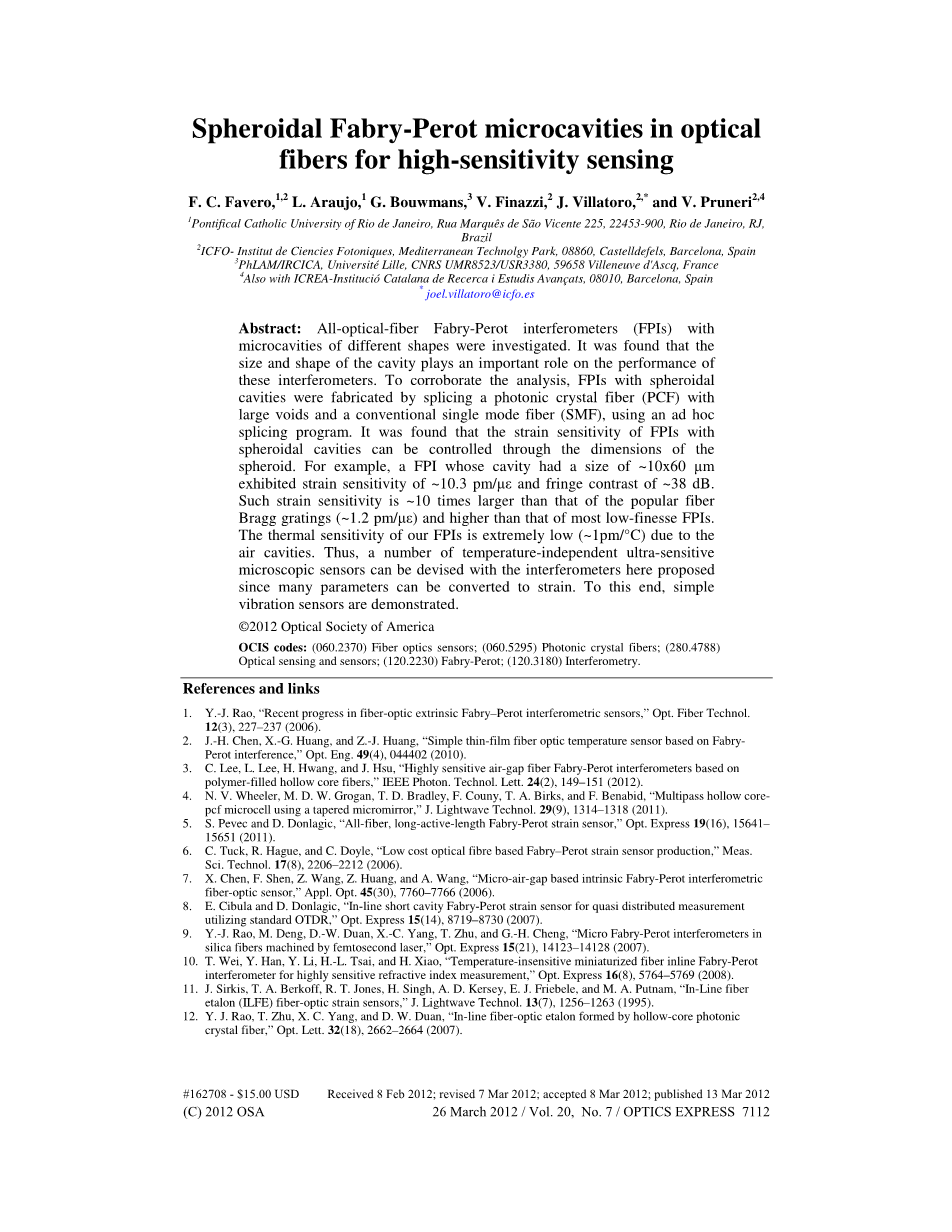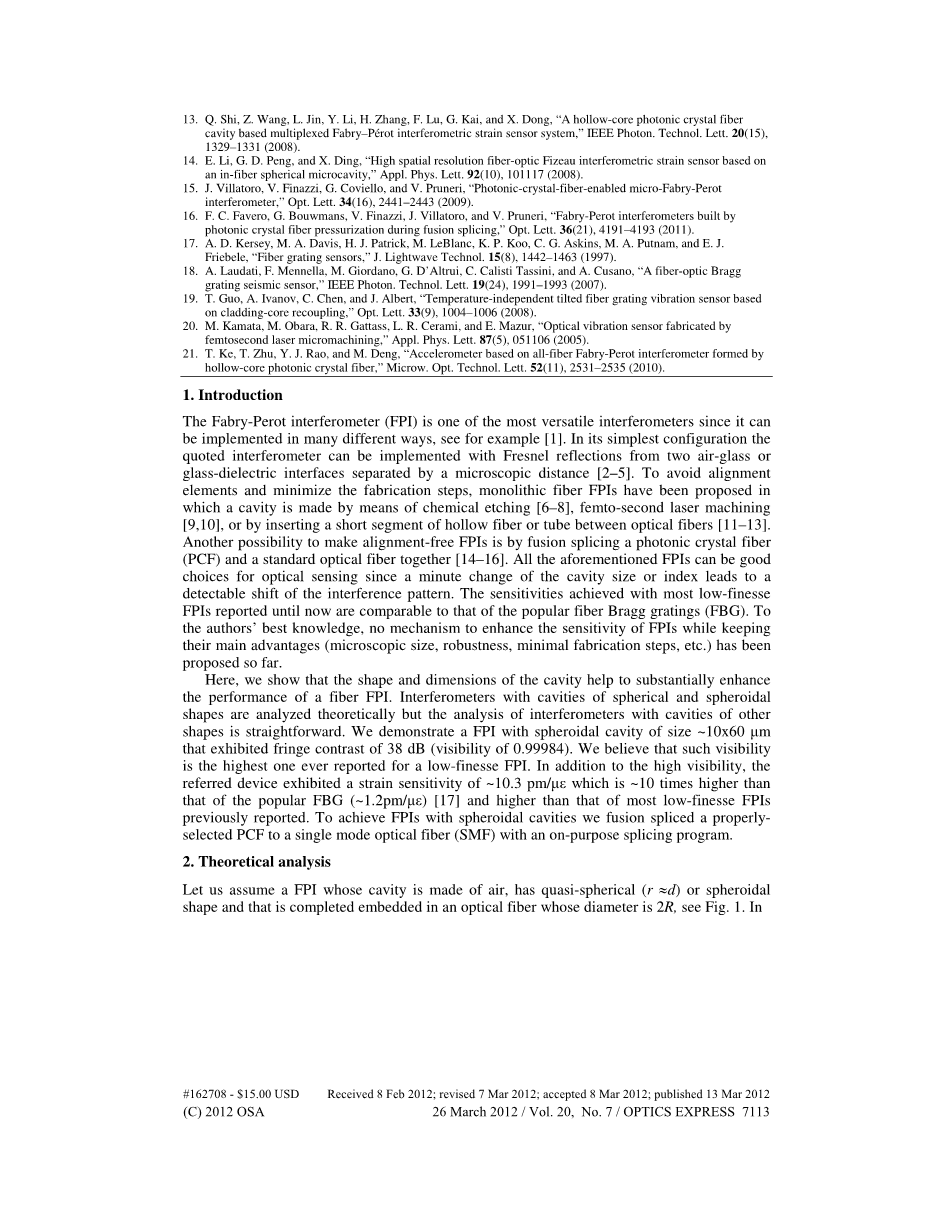

英语原文共 7 页,剩余内容已隐藏,支付完成后下载完整资料
用于高灵敏度传感的光纤法布里-珀罗球形微腔
F. C. Favero,1,2 L. Araujo, 1G. Bouwmans,3V. Finazzi,2 J. Villatoro,2,* and V.Pruneri2,4
1Pontifical Catholic University of Rio de Janeiro, Rua Marquecirc;s de Satilde;o Vicente 225, 22453-900, Rio de Janeiro, RJ,
Brazil
2ICFO- Institut de Ciencies Fotoniques, Mediterranean Technolgy Park, 08860, Castelldefels, Barcelona, Spain
3PhLAM/IRCICA, Universiteacute; Lille, CNRS UMR8523/USR3380, 59658 Villeneuve dAscq, France
4Also with ICREA-Institucioacute; Catalana de Recerca i Estudis Avanccedil;ats, 08010, Barcelona, Spain
摘要:通过研究具有不同形状微腔的全光纤法布里-珀罗干涉仪(FPIs),发现腔的大小和形状对这些干涉仪的性能有重要影响。为了证实分析,使用特殊的方法熔接具有大空隙的光子晶体光纤和传统的单模光纤来制作FPIs球形腔。结果表明,法布里-珀罗干涉仪球形腔的应变灵敏度可以通过球体的尺寸来控制。例如,空腔尺寸为~10times;60mu;m的FPIs的应变灵敏度为~10.3pm/mu;ε,条纹对比度为~38dB。这种应变灵敏度比目前流行的光纤布拉格光栅(~1.2pm/mu;ε)高出10倍,比大多数低精细度FPI的应变灵敏度高。由于空气腔的存在,FPIs的热灵敏度非常低(~1pm/°C)。由于许多参数可以转换为应变量,因此可以用这里提出的干涉仪设计许多与温度无关的超灵敏显微传感器。至此,论证了简单的振动传感器。
参考文献与链接
1. Y.-J. Rao, “Recent progress in fiber-optic extrinsic Fabry–Perot interferometric sensors,” Opt. Fiber Technol.12(3), 227–237 (2006).
2. J.-H. Chen, X.-G. Huang, and Z.-J. Huang, “Simple thin-film fiber optic temperature sensor based on Fabry-Perot interference,” Opt. Eng. 49(4), 044402 (2010).
3. C. Lee, L. Lee, H. Hwang, and J. Hsu, “Highly sensitive air-gap fiber Fabry-Perot interferometers based on polymer-filled hollow core fibers,” IEEE Photon. Technol. Lett. 24(2), 149–151 (2012).
4. N. V. Wheeler, M. D. W. Grogan, T. D. Bradley, F. Couny, T. A. Birks, and F. Benabid, “Multipass hollow corepcf microcell using a tapered micromirror,” J. Lightwave Technol. 29(9), 1314–1318 (2011).
5. S. Pevec and D. Donlagic, “All-fiber, long-active-length Fabry-Perot strain sensor,” Opt. Express 19(16), 15641–15651 (2011).
6. C. Tuck, R. Hague, and C. Doyle, “Low cost optical fibre based Fabry–Perot strain sensor production,” Meas.Sci. Technol. 17(8), 2206–2212 (2006).
7. X. Chen, F. Shen, Z. Wang, Z. Huang, and A. Wang, “Micro-air-gap based intrinsic Fabry-Perot interferometric fiber-optic sensor,” Appl. Opt. 45(30), 7760–7766 (2006).
8. E. Cibula and D. Donlagic, “In-line short cavity Fabry-Perot strain sensor for quasi distributed measurement utilizing standard OTDR,” Opt. Express 15(14), 8719–8730 (2007).
9. Y.-J. Rao, M. Deng, D.-W. Duan, X.-C. Yang, T. Zhu, and G.-H. Cheng, “Micro Fabry-Perot interferometers in silica fibers machined by femtosecond laser,” Opt. Express 15(21), 14123–14128 (2007).
10. T. Wei, Y. Han, Y. Li, H.-L. Tsai, and H. Xiao, “Temperature-insensitive miniaturized fiber inline Fabry-Perot interferometer for highly sensitive refractive index measurement,” Opt. Express 16(8), 5764–5769 (2008).
11. J. Sirkis, T. A. Berkoff, R. T. Jones, H. Singh, A. D. Kersey, E. J. Friebele, and M. A. Putnam, “In-Line fiber etalon (ILFE) fiber-optic strain sensors,” J. Lightwave Technol. 13(7), 1256–1263 (1995).
12. Y. J. Rao, T. Zhu, X. C. Yang, and D. W. Duan, “In-line fiber-optic etalon formed by hollow-core photonic crystal fiber,” Opt. Lett. 32(18), 2662–2664 (2007).
13. Q. Shi, Z. Wang, L. Jin, Y. Li, H. Zhang, F. Lu, G. Kai, and X. Dong, “A hollow-core photonic crystal fiber cavity based multiplexed Fabry–Peacute;rot interferometric strain sensor system,” IEEE Photon. Technol. Lett. 20(15),1329–1331 (2008).
14. E. Li, G. D. Peng, and X. Ding, “High spatial resolution fiber-optic Fizeau interferometric strain sensor based on an in-fiber spherical microcavity,” Appl. Phys. Lett. 92(10), 101117 (2008).
15. J. Villatoro, V. Finazzi, G. Coviello, and V. Pruneri, “Photonic-crystal-fiber-enabled micro-Fabry-Perot interferometer,” Opt. Lett. 34(16), 2441–2443 (2009).
16. F. C. Favero, G. Bouwmans, V. Finazzi, J. Villatoro, and V. Pruneri, “Fabry-Perot interferometers built by photonic crystal fiber pressurization during fusion splicing,” Opt. Lett. 36(21), 4191–4193 (2011).
17. A. D. Kersey, M. A. Davis, H. J. Patrick, M. LeBlanc, K. P. Koo, C. G. Askins, M. A. Putnam, and E. J.Friebele, “Fiber grating sensors,” J. Lightwave Technol. 15(8), 1442–1463 (1997).
18. A. Laudati, F. Mennella, M. Giordano, G. Drsquo;Altrui, C. Calisti Tassini, and A. Cusano, “A fiber-optic Bragg grating seismic sensor,” IEEE Photon. Technol. Lett. 19(24), 1991–1993 (2007).
19. T. Guo, A. Ivanov, C. Chen, and J. Albert, “Temperature-independent tilted fiber grating vibration sensor based on cladding-core recoupling,” Opt. Lett. 33(9), 1004–1006 (2008).
20. M. Kamata, M. Obara, R. R. Gattass, L. R. Cerami, and E. Mazur, “Optical vibration sensor fabricated by femtosecond laser micromachining,” Appl. Phys. Lett. 87(5), 051106 (2005).
21. T. Ke, T. Zhu, Y. J. Rao, and M. Deng, “Accelerometer based on all-fiber Fabry-Perot interferometer formed by hollow-core photonic crystal fiber,” Microw. Opt. Technol. Lett. 52(11), 2531–2535 (2010).
- 引言
法布里-珀罗干涉仪(FPI)是最通用的干涉仪之一,因为它可以通过许多不同的方式实现,参见示例[1]。在其最简单的配置中,引用的干涉仪可以用来自两个空气-玻璃或玻璃的菲涅耳反射来实现,玻璃 - 介电界面以微观距离分开[2-5]。为了避免校准要素和简化制造步骤,已经提出了单片光纤FPI,其中通过化学蚀刻[6-8]、飞秒激光加工[9,10]或通过在光纤之间插入一小段中空心纤维或细管来制造腔[11-13]。制造免校准FPI的另一种可能性是通过将光子晶体光纤(PCF)和标准光纤熔接在一起[14-16]。由于腔尺寸或折射率的微小变化可检测到干涉图案的位移,所以上述所有FPI都是用于光学传
剩余内容已隐藏,支付完成后下载完整资料
资料编号:[17760],资料为PDF文档或Word文档,PDF文档可免费转换为Word


